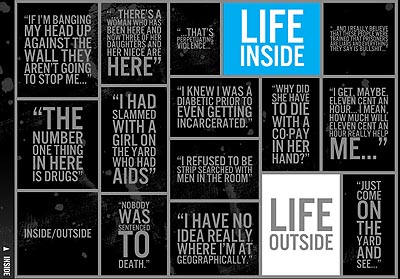By Vicki Bolam, review@ucsc.edu
"That's all I care about; getting myself outta here and getting my whole life back together."
"It seems to me that women are getting slammed with more time than men for the same crimes."
"I learned to use narcotics in prison.. my first fix came from some dope the police brought in."
These are excerpts from Public Secrets, a powerful online documentary created by professor Sharon Daniel.
Through Public Secrets, women in a California prison share their stories in candid and moving recorded narratives. They talk about their children, their mistakes, and their futures, and also about the injustices of the criminal justice system and the failures of the prison health care system.
"Their collective voices challenge our assumptions about crime and punishment, justice and injustice," says Daniel, of UCSC's Film and Digital Media Department, who is also chair of the interdisciplinary Digital Arts and New Media M.F.A. program.

Sharon Daniel
"Art is about changing awareness, perception, and understanding," she adds. "That change can be purely aesthetic or emotional, but my interest is in catalyzing social change and promoting social justice."
The visual presentation of Public Secrets is stark but compelling and dynamic, with block quotes from the narratives emerging, shifting, and vying for attention on the screen. We don't see photos of the women, but we hear their voices, and without seeing their faces we are allowed to create our own mental pictures of women who could be our mothers, our sisters, our friends.
"We take prisons for granted but are often afraid to face the realities they produce," says Angela Davis, professor emerita of history of consciousness at UC Santa Cruz in her book Are Prisons Obsolete? "We thus think about imprisonment as a fate reserved for others, a fate reserved for the 'evildoers'... relieving us of the responsibility of thinking about the real issues afflicting those communities from which prisoners are drawn in such disproportionate numbers."
Public Secrets is the first of three "database driven" new media documentaries in which Daniel explores realities often hidden from public view. The second piece in the series, Blood Sugar (now in the final production stage), shares the stories of people trapped in drug and alcohol addiction.
Daniel says that database technology makes it possible to create what she calls "multi-vocal" narratives. She sees herself as a context provider, giving voice to those shut out of the digital revolution.
"I ask the participants to share their experiences, then present their stories as transparently as possible, without adding an overall 'authorial voice,'" she says. "All of their diverse voices, including mine, come together in the work."
As with all of Daniel's work, the underlying structure of Public Secrets, its "data architecture," was shaped by the content of the stories. Rather than the typical drill-down website architecture, Public Secrets uses an array-like structure that invites exploration by topic and encourages connections across topics.
It also creates a "virtual space" that reflects the inside/outside dichotomy shared by many of the stories.
"It is as though these collective voices comprise a 100-square-mile territory," says Daniel. "I set the viewer down in the middle of this territory and allow them to come to an understanding of it through exploration-making choices and pursuing pathways based on their own interests and reactions."
Public Secrets, created in collaboration with designer Erik Loyer, was first presented in the online Vectors Journal. It was an Official Honoree of the 2007 Webby Awards.



